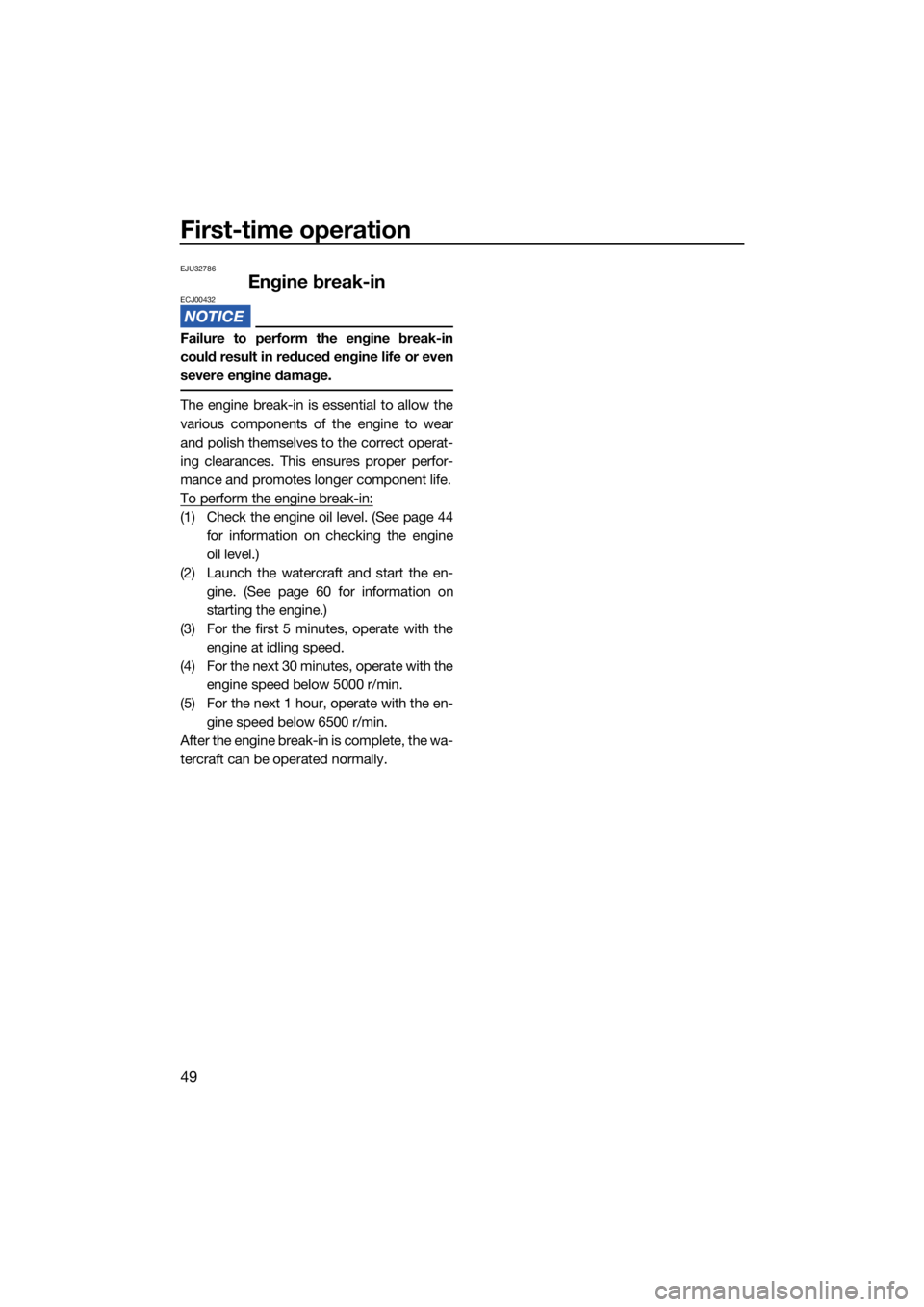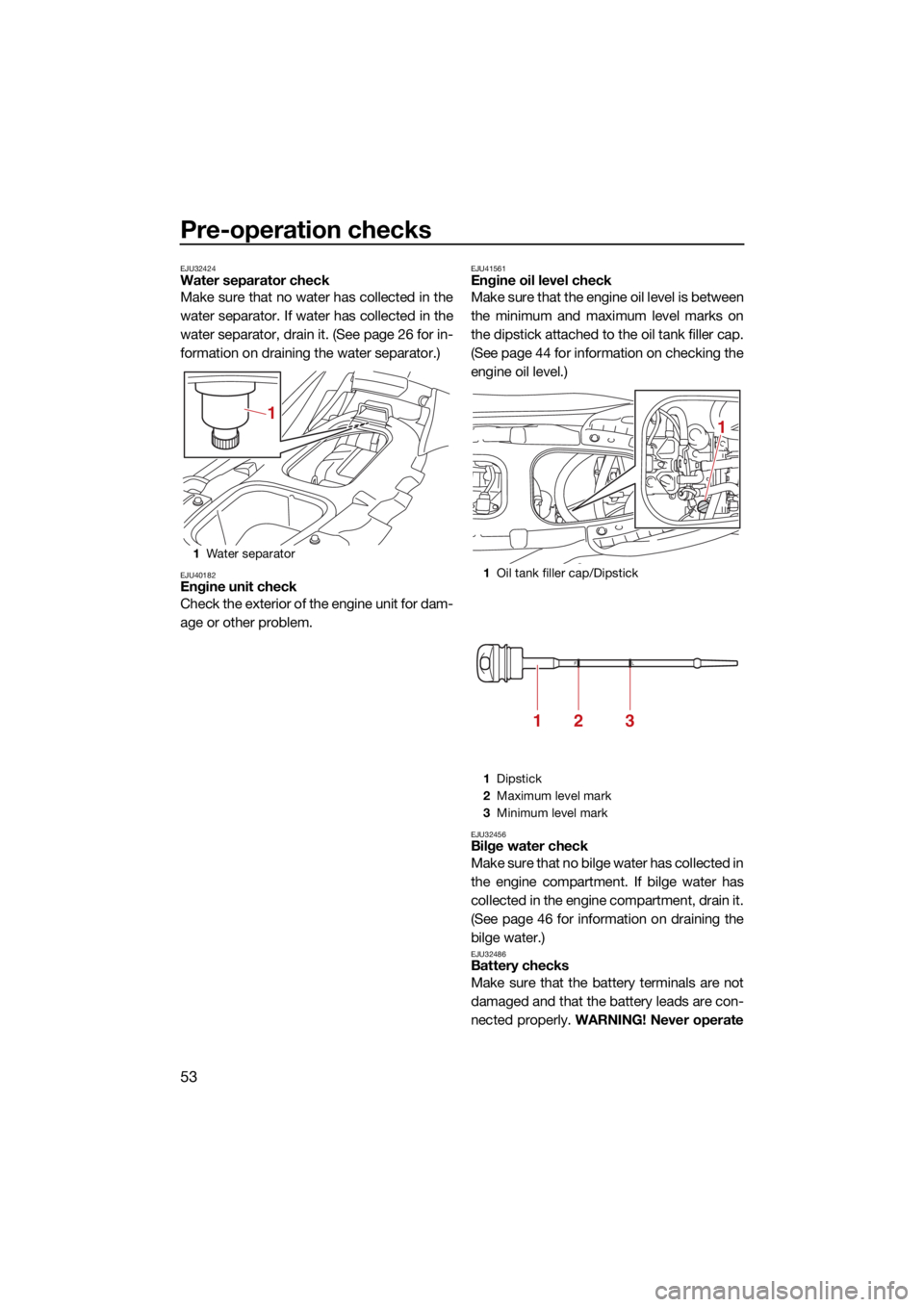2021 YAMAHA EXR engine oil
[x] Cancel search: engine oilPage 52 of 98

Operation and handling requirements
45
Checking the engine oil levelEWJ00341
Engine oil is extremely hot immediately af-
ter the engine is turned off. Coming in con-
tact with or getting any engine oil on your
clothes could result in burns.
ECJ00392
Do not run the engine with too much or
not enough oil in the oil tank, otherwise
the engine could be damaged.
Make sure that debris and water do not
enter the oil tank filler hole. Debris and
water in the engine oil can cause serious
engine damage.
TIP:
When checking the engine oil level on land,
the engine must be running while water is
being supplied to the cooling water pas-
sages. (See “Flushing the cooling water
passages” on page 71 for information on
supplying water.)
When checking the engine oil level on wa-
ter, moor the watercraft so that it will not
drift away.
To check the engine oil level:
(1) With the engine stopped, place the wa- tercraft in a precisely level position on
land or launch the watercraft.
(2) Look in all directions, and then start the engine. (See page 60 for information on
starting the engine.)
(3) Run the engine at idling speed for 6 min- utes or more. Run the engine an addi-
tional 5 minutes if the ambient
temperature is 20 °C (68 °F) or less.
(4) Stop the engine.
(5) Remove the seat and seat storage com- partment. (See page 36 for seat removal and installation procedures and page 40
for information on the seat storage com-
partment.)
(6) Loosen the oil tank filler cap and remove it, and then wipe the attached dipstick
clean.
(7) Screw the oil tank filler cap into the filler hole until it stops. Remove the oil tank
filler cap again and make sure that the
engine oil level is between the minimum
and maximum level marks.
(8) If the engine oil level is significantly above the maximum level mark, consult
a Yamaha dealer. If the engine oil level is
below the minimum level mark, slowly
add engine oil.
1Oil tank filler cap/Dipstick
1 Dipstick
2 Maximum level mark
3 Minimum level mark
1
213
UF4L72E0.book Page 45 Thursday, June 18, 2020 1:29 PM
Page 53 of 98

Operation and handling requirements
46
(9) Repeat steps 6–8 until the engine oil is atthe proper level.
(10) Securely install the oil tank filler cap and turn it until it stops.
(11) Securely install the seat storage com- partment and seat in their original posi-
tions.EJU40022
Draining the bilge waterECJ01302
Do not run the engine at full throttle when
bilge water remains in the engine com-
partment. The bilge water can splash into
the engine, which can result in severe
damage.
EJU44260Draining the bilge water on land
To drain the bilge water on land:
(1) Loosen the stern drain plugs and removethem.
(2) Raise the bow of the watercraft, such as by placing the watercraft on a slope, to
drain the bilge water from the engine
compartment.
(3) After the bilge water has drained from the stern drain plug holes, wipe up any re-
maining moisture in the engine compart-
ment with a dry cloth.
(4) Check that the stern drain plugs and O- rings on the plugs are not damaged and
that there is no foreign material on the
threads or O-rings on the plugs.
NOTICE: Before installing the stern
drain plugs, clean the drain plug
threads and the O-rings on the plugs
to remove any foreign materials, such
as dirt or sand. Otherwise, the stern
1 Stern drain plug
1
UF4L72E0.book Page 46 Thursday, June 18, 2020 1:29 PM
Page 56 of 98

First-time operation
49
EJU32786
Engine break-inECJ00432
Failure to perform the engine break-in
could result in reduced engine life or even
severe engine damage.
The engine break-in is essential to allow the
various components of the engine to wear
and polish themselves to the correct operat-
ing clearances. This ensures proper perfor-
mance and promotes longer component life.
To perform the engine break-in:
(1) Check the engine oil level. (See page 44for information on checking the engine
oil level.)
(2) Launch the watercraft and start the en- gine. (See page 60 for information on
starting the engine.)
(3) For the first 5 minutes, operate with the engine at idling speed.
(4) For the next 30 minutes, operate with the engine speed below 5000 r/min.
(5) For the next 1 hour, operate with the en- gine speed below 6500 r/min.
After the engine break-in is complete, the wa-
tercraft can be operated normally.
UF4L72E0.book Page 49 Thursday, June 18, 2020 1:29 PM
Page 57 of 98

Pre-operation checks
50
EJU31982
EWJ00412
Failure to inspect or maintain the watercraft properly increases the possibility of an ac-
cident or damage to the watercraft. Do not operate the watercraft if you find any prob-
lem. If a problem cannot be corrected by the procedures provided in this manual, have
the watercraft inspected by a Yamaha dealer.
EJU41235Pre-operation checklist
Before using this watercraft, be sure to perform the checks in the following checklist.
ITEMROUTINEPAGE
PRE-LAUNCH CHECKS
Engine compartment Ventilate the engine compartment.
Check inside the engine compartment for damage.
52
Fuel system Check the fuel system for leakage.
Check the fuel level in the fuel tank.
52
Water separator Check the water separator for water. 53
Engine unit Check the exterior of the engine unit for damage. 53
Engine oil level Check the engine oil level. 53
Bilge water Check the engine compartment for bilge water. 53
Battery Check the battery connections. 53
Steering system Check the steering system for proper operation. 54
RiDE lever Check the RiDE lever for proper operation. 54
Throttle lever Check the throttle lever for proper operation. 55
Engine shut-off cord (lan-
yard) Check the engine shut-off cord (lanyard) for dam-
age.
55
Switches Check the start switch, engine stop switch, and en-
gine shut-off switch for proper operation.
55
Storage compartments Check the storage compartments for damage and
water.
56
Fire extinguisher holder Check the fire extinguisher holder for damage. 56
Fire extinguisher Check the condition of the fire extinguisher. 56
Safety equipment Check that safety equipment meeting the applica-
ble regulations is on board.
56
Hull and deck Check the hull and deck for damage. 56
Jet intake Check the jet intake for damage and clogging. 56
Jet thrust nozzle and re-
verse gate Check the jet thrust nozzle and reverse gate for
damage.
56
Stern drain plugs Check the stern drain plugs for damage and foreign
material and check that they are securely installed.
56
Hood Check that the hood is securely closed. 57
Seat Check that the seat is securely installed. 36
UF4L72E0.book Page 50 Thursday, June 18, 2020 1:29 PM
Page 60 of 98

Pre-operation checks
53
EJU32424Water separator check
Make sure that no water has collected in the
water separator. If water has collected in the
water separator, drain it. (See page 26 for in-
formation on draining the water separator.)
EJU40182Engine unit check
Check the exterior of the engine unit for dam-
age or other problem.
EJU41561Engine oil level check
Make sure that the engine oil level is between
the minimum and maximum level marks on
the dipstick attached to the oil tank filler cap.
(See page 44 for information on checking the
engine oil level.)
EJU32456Bilge water check
Make sure that no bilge water has collected in
the engine compartment. If bilge water has
collected in the engine compartment, drain it.
(See page 46 for information on draining the
bilge water.)
EJU32486Battery checks
Make sure that the battery terminals are not
damaged and that the battery leads are con-
nected properly. WARNING! Never operate
1Water separator
1
1Oil tank filler cap/Dipstick
1 Dipstick
2 Maximum level mark
3 Minimum level mark
1
213
UF4L72E0.book Page 53 Thursday, June 18, 2020 1:29 PM
Page 85 of 98

Maintenance
78
EJU43101Periodic maintenance chart
The periodic maintenance chart gives general guidelines for periodic maintenance. Have a
Yamaha dealer perform the checks in the following chart. However, maintenance may need to be performed more frequently depending on your operating conditions. If you have any
questions, consult a Yamaha dealer.
This “ √” mark indicates items to be checked and serviced by a Yamaha dealer.
Item OperationInitial Thereafter every
Page
10 hours 50 hours
or 12
months *1 100
hours or 12
months *1 200
hours or 24
months *1
Fuel line Check fuel hoses and
clamps
√
—
Fuel filler cap/Wa-
ter separator Check O-rings for cracks
and deformation
√
—
Fuel tank Check installation and
straps
√
—
Water inlet strainer Check for clogs and dam-
age
√
—
Cooling water hos-
es Check for damage and
leakage, and check
clamps
√
—
Engine oil Replace √√ 80
Oil filter Replace √80
Spark plugs Check √√ —
Battery Check state of charge,
terminals and bands
√
—
Battery leads Check terminals √—
Steering master Check operation and for
looseness
√√
—
Steering cable Check exterior and con-
nections, and lubricate
√
—
Shift rod and re-
verse gate Check exterior and con-
nections, and lubricate
√
—
Air filter element Check for damage and
dirt
√
—
Air intake hoses Check for damage, and
check clamps
√
—
Throttle body Lubricate throttle valve √—
Exhaust system Check for exhaust leak-
age, and check hoses and
clamps √
—
Breather hose Check
breather hose and
clamps √
—
UF4L72E0.book Page 78 Thursday, June 18, 2020 1:29 PM
Page 87 of 98

Maintenance
80
EJU36943Engine oil and oil filterEWJ00341
Engine oil is extremely hot immediately af-
ter the engine is turned off. Coming in con-
tact with or getting any engine oil on your
clothes could result in burns.
ECJ00992
Do not run the engine with too much or not
enough oil in the engine, otherwise the en-
gine could be damaged.
It is recommended to have a Yamaha dealer
change the engine oil and the engine oil filter.
However, if you choose to change the oil and
filter on your own, consult a Yamaha dealer.
UF4L72E0.book Page 80 Thursday, June 18, 2020 1:29 PM
Page 88 of 98

Specifications
81
EJU45442
Specifications
Watercraft capacity:
Maximum people on board:3 person
Maximum load capacity: 225 kg (496 lb)
Dimensions and weight:
Length:
3.14 m (123.6 in)
Width: 1.13 m (44.5 in)
Height: 1.15 m (45.3 in)
Dry weight: 245 kg (540 lb)
Performance:
Maximum output (according to ISO 8665/SAE
J1228):
80.9 kW at 8000 r/min
Maximum fuel consumption: 33.1 L/h (8.7 US gal/h, 7.3 Imp.gal/h)
Cruising range at full throttle: 1.51 hour
Trolling speed:
1500 ±100 r/min
Engine:
Engine type:
Liquid cooled 4-stroke, DOHC
Number of cylinders:
3
Engine displacement: 1049 cm³
Bore × stroke:
82.0 × 66.2 mm (3.23 × 2.61 in)
Compression ratio:
11.0 : 1
Valve clearance-intake (cold): 0.15–0.22 mm (0.0059–0.0087 in)
Valve clearance-exhaust (cold): 0.26–0.32 mm (0.0102–0.0126 in)
Lubrication system:
Dry sump
Cooling system: Water
Starting system: Electric
Ignition system:
T.C.I. Spark plug (NGK):
CR9EB
Spark plug gap: 0.7–0.8 mm (0.028–0.031 in)
Battery capacity:
12 V, 18 Ah
Battery type: YTX20L-BS
Charging system: Flywheel magneto
Drive unit:
Propulsion system:Jet pump
Jet pump type: Axial flow, single stage
Impeller rotation: Counterclockwise
Jet thrust nozzle angle:
24+24 °
Fuel and oil:
Recommended fuel:Regular unleaded gasoline
Minimum octane rating (PON):
86
Minimum octane rating (RON): 90
Recommended engine oil: YAMALUBE 4W or 4-stroke motor oil
Recommended engine oil type SAE: SAE 10W-30, 10W-40, 20W-40, 20W-50
Recommended engine oil grade API: API SG, SH, SJ, SL
Fuel tank total capacity: 50 L (13.2 US gal, 11.0 Imp.gal)
Engine oil quantity with oil filter replacement:
3.4 L (3.59 US qt, 2.99 Imp.qt)
Engine oil quantity without oil filter replacement: 3.2 L (3.38 US qt, 2.82 Imp.qt)
Engine oil total quantity: 3.7 L (3.91 US qt, 3.26 Imp.qt)
UF4L72E0.book Page 81 Thursday, June 18, 2020 1:29 PM